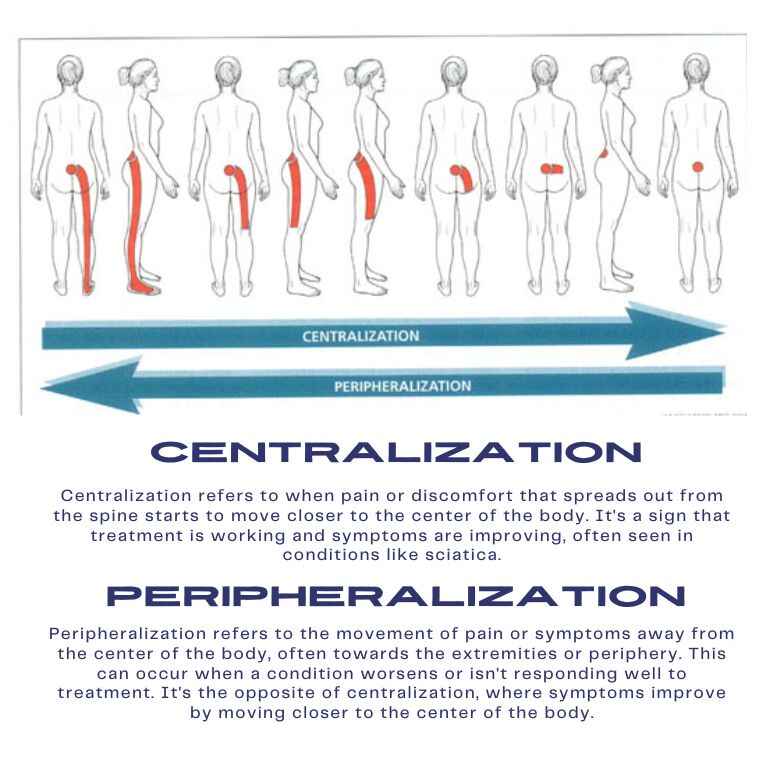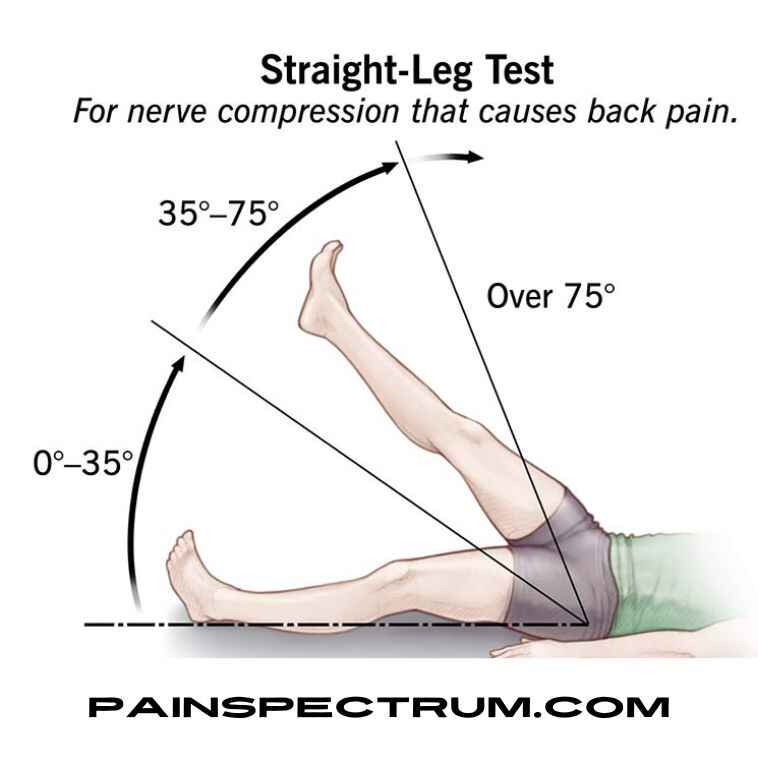
9 Signs of Sciatica Improving & Phases of Sciatica Recovery
Last updated on December 6th, 2025 at 11:01 am
Sciatica can feel like relentless pain that starts in your lower back and shoots down through your leg, affecting your daily life in ways you never imagined. But recovering from sciatica isn’t always straightforward. Sometimes the pain gets better, and other times it gets worse, making it hard to tell if you’re healing.
However, with the right treatment for your back and spine, you can reduce your symptoms and get back on track. In some cases, you might even permanently cure your sciatica.
So, how can you tell if your sciatica is improving? Fortunately, there are a few clear signs of sciatica improving that show your condition is getting better, helping you feel more comfortable in your daily life.
Here, you’ll learn about seven signs of sciatica improving, along with answers to common questions about sciatica recovery.
Table of Contents

Sciatica: Causes and Symptoms
Sciatica usually happens when a herniated disk in your lower back puts pressure on the sciatic nerve. This nerve runs from your lower back down through your buttocks and legs. People with sciatica often feel pain, numbness, or discomfort in these areas:
- Lower back
- Buttocks
- Thighs
- Knees and feet
The pain typically starts in the lower back, buttocks, and thighs. As sciatica worsens, the pain can extend further down the leg. This is called “radiation” of pain.
Most people with sciatica feel discomfort on only one side of their body. If you experience sciatica symptoms on both sides, it’s important to seek medical advice promptly, as this could indicate a more serious issue.
9 signs of sciatica improving
Sciatica can continue for several months, and about 30% of patients treated only with pain medications still feel symptoms even one to two years later. Therefore, we look to understand how your symptoms are improving with these 9 signs of sciatica improving.
1. Centralisation of sciatic pain
Sciatica starts in the hip area and spreads down towards the legs over time, worsening as it progresses. A key sign of improvement is when the pain starts to retreat towards the hip. This is called centralizing it.
Although the pain is still quite high, if it’s decreasing towards your feet from your lower back, it’s a great sign of improvement in your sciatica. The more the pain around your spine and hips decreases, and the less pain you feel in your feet, it shows that your sciatica is getting better.
In most cases, there’s no need for successful attempts to fix a herniated disc. Therefore, you don’t always need surgery, steroid injections, or other treatments to relieve your sciatica pain. However, if your pain is severe or long-lasting, these treatments can speed up your healing process.
2. Pain is less intense and frequent
Centralization is important, but the real goal is to achieve relief from pain. Therefore, if you feel a decrease in the frequency or intensity of pain, it’s a good sign. For example, sneezing or coughing might cause less discomfort, or you might feel tingling or pins and needles in your leg or buttock instead of burning or throbbing.
However, a decrease in pain doesn’t necessarily mean that your sciatica is getting worse. You might still experience a similar amount of discomfort in your buttocks, but if the centralization of pain is starting, it also indicates improvement in your sciatica.

3. Improved mobility
If your sciatica pain is making it difficult to walk or move, improvement in movement is a great sign. Being able to engage in more activities than before suggests that your sciatica is getting better.
Self-mobilization and sciatica massage methods have been shown to promote soft tissue exposure and numb your sciatic nerves, which can improve your symptoms. Therefore, actively participating in your treatment is also a good way to speed up recovery.
4. Fewer muscle spasms
Sciatica can include symptoms of pain in the buttocks. This can be challenging because the buttocks nerves can be affected, which may increase sciatic pain. Therefore, sometimes smiling is used in treatment to help relax the buttock muscles.

Feeling less pain in your back muscles can indicate that your sciatica is improving, and the chance of it coming back may decrease.
5. Your muscles feel stronger
If your sciatic nerves are inflamed, your leg muscles might feel weaker than usual. This weakness in the leg muscles is often a sign that your sciatica is not improving well.
Improving muscle strength can help you determine if your sciatica is getting better or not. You might notice you can walk longer distances or stand for longer periods than before.
6. Less pain in the straight leg raise test
The straight leg raise test is a common diagnostic test for suspected sciatica. Here’s how it works: You lie on your back, and a doctor lifts your leg straight up while keeping your hip bent. If you feel pain during this test, especially between a 30° to 70° angle, it could indicate sciatica.
You can perform this test at home with the help of a friend or partner. Use it to feel and track your pain levels and see if your sciatica symptoms are improving or not.
7. Diagnostic imaging tests show positive results
Diagnostic imaging such as MRI is usually used for sciatica patients when the doctor suspects a serious underlying cause or if symptoms persist for several months without improvement. If you’ve already had diagnostic imaging for sciatica, your doctor may recommend additional tests to better understand your condition and improve your treatment options. These tests can help assess the possibilities for improving sciatica symptoms.
8. Decreased reliance on pain medications:
As your sciatica improves, you may find that you need less pain medication to manage your symptoms. This reduction in medication dependency suggests that the underlying condition causing your sciatica is resolving.
9. Improved sleep quality:
Sciatica pain can severely disrupt sleep due to discomfort while lying down. As your symptoms improve, you may find it easier to fall asleep, stay asleep longer, and wake up feeling more rested. Better sleep quality is a positive indicator that your sciatica is getting better.
Read More: 9 Best Treatment Options for Sciatica Pain
Phases of Sciatica Recovery
Phase 1: Reducing Inflammation
The first step in sciatica recovery focuses on reducing inflammation. This is crucial as inflammation exacerbates nerve pain. Simple home remedies like applying ice packs, gentle stretching, and over-the-counter anti-inflammatory medication can be effective. Recognizing a decrease in sharp, shooting pain can be a sign of improvement during this phase.
Phase 2: Nerve and Tissue Healing
Once inflammation subsides, your body starts healing the nerve and surrounding tissues. This phase may involve more specialized treatments such as physical therapy or acupuncture to promote healing. Improvement signs include reduced pain frequency and intensity, indicating that the nerve is healing.
Phase 3: Strengthening and Prevention
Strengthening the muscles around the sciatica nerve and improving flexibility are key to preventing future episodes. This stage may include targeted exercises and lifestyle adjustments, like improving posture and incorporating regular physical activity. Feeling stronger and more flexible with less discomfort signals progress in this phase.
The journey to full recovery is gradual. Recognizing milestones, such as being able to sit, stand, and walk comfortably or returning to daily activities without pain, are positive indicators of your transition to full health.
Prevention
Making simple lifestyle changes, such as keeping good posture, staying active, and avoiding sitting for too long, can greatly lower the chances of sciatica coming back. Regular visits to a chiropractor for adjustments can keep your spine aligned, easing pressure on the sciatic nerve and preventing future episodes. Working with a physical therapist to do exercises tailored to strengthen your back muscles and improve flexibility can also help prevent sciatica from returning.
FAQ
Does Pins and Needles Sensation Mean Improvement?
Pins and needles, or tingling sensations, can indicate that the nerve is starting to recover. However, it’s essential to monitor these sensations closely as they should gradually decrease rather than persist or worsen.
Does Sciatica Get Worse Before It Gets Better?
It’s a common myth that sciatica must worsen before it gets better. In reality, with appropriate care, symptoms should gradually improve. Any increase in pain should be discussed with a healthcare provider.
How Long Does Sciatica Pain Last?
The duration of sciatica pain varies. Acute episodes might last a few weeks, while chronic conditions could persist longer. Following a tailored treatment plan can accelerate the healing process.
Managing Expectations and Setbacks
Recovery is rarely linear. Setbacks can occur, but they’re part of the healing journey. Setting realistic goals and celebrating small improvements can help manage expectations and maintain a positive outlook.
Average Time Off Work with Sciatica
The time off work can vary widely depending on the severity of your symptoms and your job nature. Many people can return to work within a few days to a couple of weeks, while others may need more extended periods, especially for physically demanding jobs.
Stage 4 Sciatica: Understanding Severe Conditions
Stage 4 sciatica refers to chronic and severe conditions where symptoms persist despite treatment. This stage may require more advanced interventions, such as surgery, to alleviate symptoms.
How Does It Feel When Sciatica Is Healing?
As sciatica begins to heal, you’ll notice a gradual decrease in pain and discomfort. The intensity of sharp, shooting pains should lessen, and you may find increased mobility and less reliance on pain medications.
How Do You Know When Sciatica Is Getting Better?
Signs of improvement include reduced pain, increased flexibility, and the ability to engage in daily activities without discomfort. Sleeping through the night without waking up due to pain is another positive indicator.
What Are the Last Stages of Sciatica?
In the final stages of recovery, symptoms become infrequent and may disappear altogether. You’ll be able to easily perform most activities and maintain a normal level of function without pain.
How Many Days Does It Take to Cure Sciatica?
The duration of sciatica can vary, with acute cases resolving in a few weeks, while chronic conditions may take several months or more. Early treatment can help speed up recovery.
How Can I Speed Up My Sciatica Recovery?
Speeding up recovery involves a combination of rest, gentle exercise, physical therapy, and, if necessary, medication. Listening to your body and avoiding activities that worsen your symptoms is crucial.
What Is the Longest Time Sciatica Can Last?
In chronic cases, sciatica can last several months to years. However, with appropriate management and treatment, most people can find relief from their symptoms.
Is Sciatica 100% Curable?
While many people recover fully from sciatica, some may experience recurring episodes or chronic symptoms. Managing underlying conditions and maintaining a healthy lifestyle can help prevent recurrences.
Does Sciatica Ever Fully Heal?
Yes, many individuals fully recover from sciatica, especially with timely and effective treatment. However, it’s important to continue with preventative measures to avoid recurrence.
What Not to Do with Sciatica?
Avoid heavy lifting, sitting for prolonged periods, and twisting movements that can exacerbate your symptoms. It’s also wise to avoid neglecting the condition, hoping it will “just go away” without treatment.
Why Sciatica Takes So Long to Heal?
Sciatica involves nerve inflammation and can take time to heal because nerves recover slowly. Additionally, symptoms may persist if the underlying cause, like a herniated disc, isn’t addressed.
What Makes Sciatica Worse?
Poor posture, sitting for long periods, and a sedentary lifestyle can worsen sciatica. Stress and not following a consistent treatment plan can also exacerbate symptoms.
How Do You Sit with Sciatica?
Choose a chair that provides good lower back support, keep your feet flat on the ground, and avoid crossing your legs. Taking short breaks to stand and stretch can also help.
Can Sciatica Lead to Paralysis?
While sciatica itself doesn’t lead to paralysis, severe underlying conditions causing sciatica, like a significant spinal injury, could potentially have more serious consequences if not treated.
What Is the Name of the Medicine for Sciatica?
Medications for sciatica range from over-the-counter pain relievers, like ibuprofen, to prescription medications for more severe pain. Always consult with a healthcare provider for the best treatment option.
Can Sciatica Take 2 Years to Heal?
In very chronic and severe cases, complete recovery from sciatica can take a long time, even up to 2 years, especially without proper treatment.
How Do You Walk with Sciatica Pain?
Walking with sciatica involves maintaining good posture and taking short, gentle strides. Wear supportive shoes and avoid uneven surfaces to prevent aggravating your symptoms.
conclusion
In conclusion, recovering from sciatica is a journey that requires patience, understanding, and consistent care. Remember, improvements can come gradually, so it’s important to celebrate small victories along the way.
Paying attention to your body and noticing signs like reduced pain, increased mobility, and less frequent muscle spasms can help you stay motivated. Implementing lifestyle changes, such as staying active and practicing good posture, plays a key role in both recovery and prevention of future episodes.
Don’t hesitate to seek professional help, as treatments like physical therapy and chiropractic care can significantly aid in your recovery process. Keep in mind that while sciatica can be challenging, with the right approach and mindset, full recovery is possible.
Stay positive, stay informed, and take active steps toward your health, and you’ll find your path to relief from sciatica pain.


